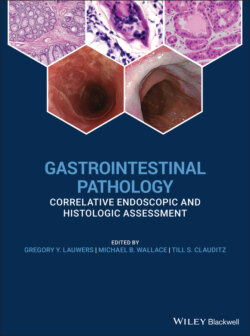Читать книгу Gastrointestinal Pathology - Группа авторов - Страница 89
Microscopic Features
ОглавлениеThe histologic features of esophageal GVHD are similar to those of other sites in the GI tract. The squamous epithelium exhibits apoptosis, intraepithelial lymphocytosis, basal vacuolization, and necrosis in severe cases (Figure 2.21). Apoptotic keratinocytes are prominent in the basal and suprabasal region and the associated lymphocytosis can have a lichenoid interface appearance. The extent of the findings can be graded as mild, moderate, or severe. Severe GVHD is characterized by erosion and/or ulceration. Involvement of deeper layers with submucosal fibrosis has been described in chronic GVHD, but this layer is seldom represented in biopsy samples. Due to potential discordance among the observed clinical severity, endoscopic abnormalities, and histologic findings, it is recommended that a minimum of 8–10 serial H&E stained sections be cut to detect minimal histologic changes of GVHD. Finally, comparison to prior biopsies should be noted in order to assess treatment effects.
Figure 2.19 Endoscopic appearance of acute GVHD of esophagus with diffuse mucosal desquamation.
Figure 2.20 Endoscopic appearance of inflammatory stricture with persistent desquamation in chronic esophageal GVHD.
Figure 2.21 Microscopic appearance of acute GVHD of esophagus with basal apoptosis, lymphocytic infiltration, and dyskeratotic epithelial elements.
